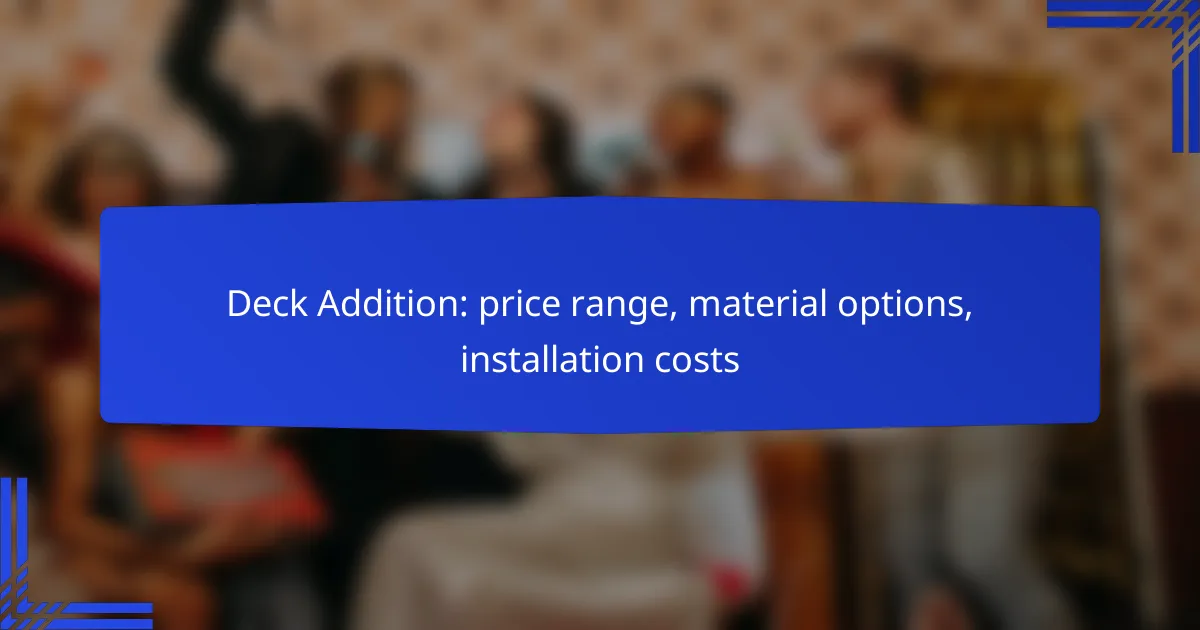When considering a deck addition, homeowners in the UK can expect prices to range from £100 to £300 per square meter, influenced by material choices and installation complexity. Popular materials such as timber, composite, and aluminium each come with distinct advantages and varying costs. Additionally, installation expenses can fluctuate widely, typically ranging from a few thousand to over ten thousand dollars, depending on the project’s specifics.

What is the price range for deck additions in the UK?
The price range for deck additions in the UK typically falls between £100 and £300 per square meter, depending on various factors such as materials and installation complexity. Homeowners should consider both the upfront costs and potential long-term value when planning a deck addition.
Average cost per square meter
The average cost per square meter for a deck addition can vary significantly based on the materials used. For example, timber decking usually ranges from £100 to £150 per square meter, while composite materials can cost between £150 and £250 per square meter. Premium options, like hardwood, may exceed £300 per square meter.
Factors affecting pricing
Labour costs also play a crucial role; hiring experienced contractors may raise expenses but can ensure quality workmanship and compliance with local regulations. Always obtain multiple quotes to compare pricing and services.
Regional price variations
Deck addition prices can vary across different regions in the UK. Generally, urban areas like London may see higher costs due to increased demand and living expenses, while rural regions might offer more competitive pricing. It’s advisable to research local contractors and materials to get a clearer picture of expected costs in your area.
Additionally, regional availability of materials can affect pricing. For example, locally sourced timber may be cheaper than imported options, impacting the overall budget for your deck addition.

What are the material options for deck additions?
Deck additions can be made from various materials, each offering unique benefits and considerations. The most common options include timber, composite, and aluminium, which vary in cost, durability, and maintenance requirements.
Timber decking materials
Timber decking is a traditional choice known for its natural beauty and warmth. Common types include pressure-treated pine, cedar, and redwood, with prices typically ranging from $15 to $30 per square foot, depending on the wood type and quality.
When selecting timber, consider factors such as durability, susceptibility to rot, and maintenance needs. Regular sealing and staining can extend the life of timber decks, but they require more upkeep compared to other materials.
Composite decking options
Composite decking is made from a blend of wood fibers and plastic, offering a low-maintenance alternative to timber. Prices generally range from $20 to $40 per square foot, reflecting its durability and resistance to fading, staining, and insects.
This material is available in various colors and textures, allowing for customization while providing a consistent look. While composite decking does not require regular sealing, it can be more expensive upfront compared to traditional wood options.
Aluminium decking benefits
Aluminium decking is a modern choice that boasts exceptional durability and resistance to the elements. Its lightweight nature and non-combustible properties make it ideal for areas prone to moisture or fire, with costs typically ranging from $30 to $50 per square foot.
Aluminium decks require minimal maintenance and are resistant to rust and corrosion. They can also be designed with integrated drainage systems, which can be beneficial in wet climates. However, the initial investment is higher compared to timber and composite options.

What are the installation costs for deck additions?
The installation costs for deck additions can vary significantly based on factors like materials, size, and labor. Generally, homeowners can expect to spend anywhere from a few thousand to over ten thousand dollars depending on these variables.
Labour costs in the UK
In the UK, labor costs for deck installation typically range from £100 to £200 per day per worker. The total labor expense will depend on the complexity of the project and the time required to complete it, which can range from a few days to a week.
For larger or more intricate decks, hiring a skilled contractor may be necessary, which could increase labor costs. Always obtain multiple quotes to ensure competitive pricing.
DIY vs professional installation
Choosing between DIY and professional installation significantly impacts overall costs. DIY installation can save money on labor but requires time, skill, and the right tools. If you lack experience, mistakes can lead to additional expenses.
Professional installation, while more costly, often guarantees quality and adherence to local building codes. Weigh the potential savings against the risks of DIY to make an informed decision.
Hidden costs to consider
When planning a deck addition, it’s crucial to account for hidden costs that can arise. These may include permits, site preparation, and potential landscaping adjustments after installation. Permits can vary in cost based on local regulations.
Additionally, consider the cost of materials that may not be included in initial estimates, such as fasteners, sealants, or finishes. Always budget for unexpected expenses to avoid financial strain during the project.

What factors influence deck addition pricing?
Deck addition pricing is influenced by several key factors, including the size and complexity of the project, the quality and type of materials used, and local building regulations. Understanding these elements can help homeowners make informed decisions and budget effectively.
Deck size and complexity
The size and complexity of a deck addition significantly impact its overall cost. Larger decks require more materials and labor, which can increase expenses. Additionally, intricate designs or multi-level structures may involve more engineering and construction time, further driving up costs.
For example, a simple rectangular deck might cost less than a custom-shaped deck with built-in seating and railings. Homeowners should consider both their desired size and any unique features they want to include when estimating costs.
Material quality and durability
The choice of materials plays a crucial role in deck addition pricing. Common materials include pressure-treated wood, composite decking, and hardwoods, each with varying costs and durability. Pressure-treated wood is typically the most affordable option, while composite materials offer longevity and low maintenance at a higher price point.
Homeowners should weigh the initial costs against long-term benefits. For instance, while composite decking may have a higher upfront cost, its durability and reduced maintenance can lead to savings over time.
Local building regulations
Local building regulations can affect deck addition pricing by requiring permits, inspections, or specific construction standards. These regulations vary by location and can influence the design and materials used, potentially adding to the overall cost.
Before starting a project, homeowners should check with local authorities to understand the necessary permits and regulations. This proactive approach can help avoid unexpected expenses and ensure compliance with local codes.

How to choose the right decking material?
Choosing the right decking material involves considering factors like durability, maintenance, environmental impact, and long-term cost-effectiveness. Each material has its own strengths and weaknesses, so understanding these aspects will help you make an informed decision.
Durability and maintenance
Durability is crucial when selecting decking materials, as it affects the lifespan and maintenance requirements of your deck. Common materials include wood, composite, and PVC, each with different durability levels. For instance, treated wood can last around 15-20 years, while composite materials often exceed 25 years with minimal upkeep.
Maintenance varies significantly among materials. Wood requires regular sealing and staining to prevent rot and weathering, while composite and PVC options typically need only occasional cleaning. Consider your willingness to maintain the deck when making your choice.
Environmental impact
The environmental impact of decking materials is an important consideration for eco-conscious homeowners. Natural wood is renewable but can contribute to deforestation if not sourced sustainably. Look for certifications like FSC (Forest Stewardship Council) to ensure responsible sourcing.
Composite materials often contain recycled plastics and wood fibers, reducing waste but may involve energy-intensive manufacturing processes. Assess the lifecycle of each material to understand its overall environmental footprint.
Cost-effectiveness over time
Cost-effectiveness is determined by both initial investment and long-term expenses. While natural wood may have a lower upfront cost, ongoing maintenance can add up significantly over time. In contrast, composite materials usually have a higher initial price but require less maintenance, potentially saving money in the long run.
When evaluating cost-effectiveness, consider the total cost of ownership, including installation, maintenance, and replacement. A well-chosen decking material can provide value for years, making it essential to weigh these factors carefully before deciding.

What are the latest trends in deck additions?
The latest trends in deck additions focus on sustainability, technology integration, and innovative designs that enhance outdoor living. Homeowners are increasingly prioritizing eco-friendly materials, smart decking solutions, and creative layouts that maximize space and functionality.
Eco-friendly materials
Eco-friendly materials are gaining popularity in deck additions due to their sustainability and reduced environmental impact. Options like composite decking made from recycled plastics and wood fibers, as well as sustainably sourced hardwoods, are commonly chosen for their durability and aesthetic appeal.
When selecting eco-friendly materials, consider the long-term benefits such as lower maintenance costs and resistance to weathering. Prices for these materials can vary, typically ranging from moderate to higher-end, depending on the type and brand.
Smart decking solutions
Smart decking solutions incorporate technology to enhance the functionality of outdoor spaces. Features like integrated lighting, heating systems, and even built-in speakers are becoming more common, allowing homeowners to enjoy their decks year-round.
Investing in smart decking can increase both convenience and safety. For example, motion-sensor lights can improve visibility at night, while heated decks can provide comfort during colder months. Costs for these solutions can vary widely, often adding a few hundred to several thousand dollars to the overall project.
Design innovations for outdoor spaces
Design innovations in deck additions focus on creating multi-functional outdoor spaces that blend seamlessly with the home. This includes features like built-in seating, planters, and outdoor kitchens that encourage social interaction and relaxation.
When planning a deck addition, consider how the design can enhance your lifestyle. For instance, incorporating a fire pit or a pergola can create a cozy atmosphere for gatherings. Budgeting for these design elements typically involves a range of costs, depending on the complexity and materials chosen. Aim for a balance between aesthetics and functionality to maximize your investment.
